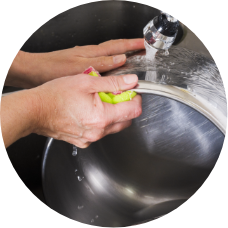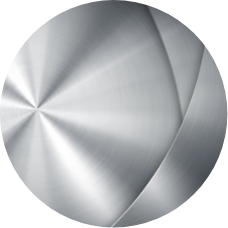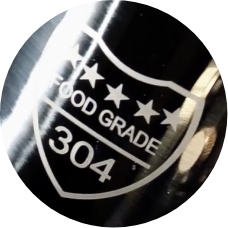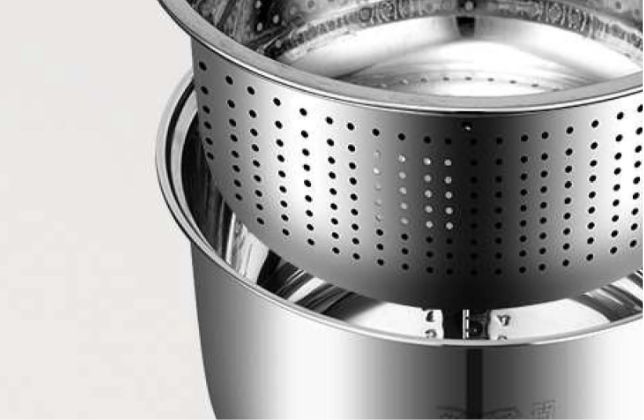ACook Cookware Australia
Low Sugar Rice Made Possible with BOILSTEAM Technology
Acook’s innovative BOILSTEAM technology is a two-step cooking method that boils then steams rice, resulting in fluffier, tastier rice that is also lower in calories and sugar.
What’s So Good About 304 Stainless Steel?


Easy To Clean
Your time is valuable - a simple scrub and rinse is all it takes to clean stainless steel.

Bacteria & Toxin Resistant
Stainless steel’s smooth surface makes it almost impossible for bacteria to gather.
Durable & Sturdy
304 Stainless steel is virtually indestructible and ultra resistant to scratches and corrosion.

PTOA & BPA-Free
Worried about potential chemical poisoning? Don’t be - stainless steel prevents chemicals leaking into your food.


Easy To Clean
Your time is valuable - a simple scrub and rinse is all it takes to clean stainless steel.

Durable & Sturdy
304 Stainless steel is virtually indestructible and ultra resistant to scratches and corrosion.

Bacteria & Toxin Resistant
Stainless steel’s smooth surface makes it almost impossible for bacteria to gather.

Ptoa & Bpa-Free
Worried about potential chemical poisoning? Don’t be - stainless steel prevents chemicals leaking into your food.
An Inner Pot that is both
Convenient & Durable

An Inner Pot that is both
Convenient & Durable

Don’t spend your whole life cleaning. The Acook’s unique build and design is specifically made to make washing its inner pot incredibly easy to clean.

The Acook’s inner pot is built to last. With a sturdy design and durable materials, you’ll be able to use your ACook over and over again.
The Best Rice Cooker
For A Healthy Lifestyle
Our rice cookers are made from stainless steel, which is a non-toxic, inert material that is safe for contact with food. Unlike conventional rice cookers, Acook’s rice cooker will not leach harmful chemicals into your food, even when heated to high temperatures.

The Best Rice Cooker
For A Healthy Lifestyle

Our rice cookers are made from stainless steel, which is a non-toxic, inert material that is safe for contact with food. Unlike conventional rice cookers, Acook’s rice cooker will not leach harmful chemicals into your food, even when heated to high temperatures.
Perfect for Cooking
Low GI Rice
Our rice cooker uses a special BOILSTEAM technology, allowing you to cook all kinds of rice perfectly while reducing the sugar from rice. We are creating healthier options for a better lifestyle!
- ✓ Low GI Rice
- ✓ Wild Rice
- ✓ Brown Rice
- ✓ Sticky Rice
- ✓ Sushi Rice
- ✓ Arborio Rice
More Than Just A
Rice Cooker
The Acook isn’t afraid to step out of its comfort zone. Its versatility lets you perfectly cook a wide range of meals including soups, stews and more!













Healthier, Tastier Cooking
Yes, it’s possible - the Acook’s stainless steel pot guarantees your meals are not only delicious but healthy as well.



A Cooker Made To Last
The Acook’s tough and durable build will have it cooking perfect rice today, tomorrow and every day after that.
Better Features.
Better Food.

Better Features.
Better Food.

Steel Pot

Screen

Technology

Cooking

Functional

Preset

Steel Pot

Screen

Technology

Cooking

Functional

Preset
Designed to Make Life
a Little Easier

Easy Operation
Rice shouldn’t be overly complicated. Get beautifully cooked rice with literally a single push of a button.

Healthy Rice Option
Enjoy tasty, fluffy and evenly cooked rice without the guilt. The healthy rice function is certified to effectively reduce sugar in rice by up to 35-41%, expertly designed for healthier meals and low sugar perfection.

Dishwasher Safe
Cut back the cleaning time even further - the Acook’s stainless steel pot is absolutely dishwasher safe.
Non-Toxic Rice Cookers: A Healthy Choice for Your Kitchen
In today’s health-conscious world, we’re increasingly aware of the impact our everyday choices have on our well-being. From the food we eat to the air we breathe, we’re constantly seeking ways to reduce our exposure to harmful substances. But have you ever stopped to consider the cookware you use to prepare your meals? Specifically, let’s talk about that humble kitchen staple: the rice cooker.
Rice is a dietary cornerstone for billions of people worldwide, and for many, a rice cooker is an indispensable kitchen appliance. However, not all rice cookers are created equal, especially when it comes to the materials used in their construction. This is where non-toxic rice cookers enter the picture, offering a safer alternative for health-conscious consumers.
As we delve into the world of non-toxic rice cookers, it’s worth highlighting innovative companies like ACook (https://www.acook.com.au/). ACook has been at the forefront of developing kitchen appliances that prioritize both functionality and health safety. Their commitment to using non-toxic materials in their products aligns perfectly with the growing demand for healthier cooking options.
In this blog post, we’ll explore the importance of choosing a non-toxic rice cooker, what features to look for, and how it can contribute to a healthier lifestyle. Whether you’re a rice enthusiast, a health-conscious cook, or simply someone looking to make smarter choices in the kitchen, this guide will help you understand why non-toxic rice cookers are becoming an essential part of modern, health-aware households.
Join us as we uncover the benefits of non-toxic rice cookers and discover how brands like ACook are revolutionizing the way we think about cooking our favorite grains. It’s time to make your kitchen not just a place of culinary creativity, but also a bastion of health and safety.
Understanding Non-Toxic Rice Cookers
When we talk about non-toxic rice cookers, we’re referring to appliances designed and manufactured with materials that don’t leach harmful chemicals into your food. But what exactly does this mean, and why is it important?
Definition of Non-Toxic Materials
Non-toxic materials are those that don’t release harmful substances when exposed to heat, acidic foods, or regular use. In the context of rice cookers, this typically includes:
- Ceramic
- Stainless steel
- Glass
- Certain food-grade silicones
These materials are chosen for their stability and inertness, ensuring that your rice and other foods remain uncontaminated during the cooking process.
Common Materials Used in Traditional Rice Cookers
Many conventional rice cookers use materials that, while functional, may pose potential health risks:
- Aluminum: Can leach into food, especially when cooking acidic ingredients.
- Non-stick coatings (like Teflon): May release harmful fumes when overheated.
- Plastic components: Can contain BPA or phthalates, which are known endocrine disruptors.
Benefits of Non-Toxic Alternatives
Choosing a non-toxic rice cooker, like those offered by ACook, comes with several significant benefits:
- Health Safety: Eliminates the risk of ingesting harmful chemicals that can leach from cookware.
- Better Taste: Non-reactive materials don’t alter the flavor of your food.
- Durability: High-quality, non-toxic materials often last longer than their traditional counterparts.
- Environmental Friendliness: Many non-toxic materials are more sustainable and recyclable.
- Peace of Mind: Knowing your cookware isn’t introducing toxins into your food reduces stress and enhances the enjoyment of your meals.
By understanding what makes a rice cooker non-toxic, you can make an informed decision about which appliance is right for your kitchen. Brands like ACook are leading the way in providing these safer alternatives, ensuring that your daily rice preparation isn’t just convenient, but also contributes to your overall health and well-being.
In the next section, we’ll explore the key features to look for when shopping for a non-toxic rice cooker, helping you make the best choice for your needs.
Key Features to Look for in Non-Toxic Rice Cookers
When shopping for a non-toxic rice cooker, it’s important to know what features to prioritise. Here are the key elements to consider:
1. Material Composition
The primary consideration for a non-toxic rice cooker is the material used in its construction, especially for parts that come into direct contact with food.
- Ceramic: Offers excellent heat distribution and is naturally non-stick when glazed properly. Look for lead-free ceramic options.
- Stainless Steel: Durable, easy to clean, and doesn’t react with food. Opt for high-grade stainless steel (304 or 316 grade).
- Glass: Inert and doesn’t leach chemicals. It allows you to see the cooking process but may be more fragile.
- Clay: Some traditional rice cookers use unglazed clay, which is non-toxic and can enhance flavor, but requires specific care.
Buffalo Cookware offers a range of rice cookers that prioritize these safe materials, ensuring your meals are free from harmful chemicals.
2. Non-Stick Coatings
If you prefer a non-stick surface:
- Avoid traditional PTFE (Teflon) coatings.
- Look for ceramic-based non-stick coatings or naturally non-stick surfaces.
- Consider rice cookers with a well-designed stainless steel or ceramic inner pot that doesn’t require a non-stick coating.
3. Safety Certifications
Reputable non-toxic rice cookers should have certifications that attest to their safety:
- FDA Approval: Ensures the product meets food safety standards.
- Prop 65 Compliance: Indicates the product is free from chemicals known to cause cancer or reproductive harm.
- RoHS Certification: Restricts the use of specific hazardous materials in electronic products.
4. Additional Features to Consider
While focusing on non-toxic materials, don’t overlook other important features:
- Cooking Settings: Look for versatile options that allow you to cook different types of rice and grains.
- Keep Warm Function: Ensure it maintains food at a safe temperature without compromising the non-toxic benefits.
- Capacity: Choose a size that suits your household needs.
- Energy Efficiency: Look for models with good insulation and energy-saving features.
- Ease of Cleaning: Removable, dishwasher-safe parts can make maintenance simpler.
5. Brand Reputation
Consider brands with a strong commitment to health and safety. ACook, for instance, has built a reputation for producing high-quality, non-toxic kitchen appliances.
By prioritizing these features, you can select a rice cooker that not only cooks your rice perfectly but also contributes to a healthier cooking environment in your kitchen. Remember, investing in a quality non-toxic rice cooker is an investment in your long-term health and well-being.
How to Use and Maintain Your Non-Toxic Rice Cooker
Proper use and maintenance of your non-toxic rice cooker not only ensures delicious results but also prolongs the life of your appliance. Here are some best practices, with a focus on ACook’s high-quality non-toxic rice cookers.
Best Practices for Cooking
- Measure Accurately: Use the measuring cup provided with your ACook rice cooker for best results. The water-to-rice ratio is crucial for perfect texture.
- Rinse the Rice: Unless you’re using enriched rice, rinse it before cooking to remove excess starch. This is especially important with non-stick ceramic cookers like ACook’s Ceramic Rice Cooker Deluxe.
- Don’t Overfill: Respect the maximum capacity line in your cooker. Overfilling can lead to boil-overs and undercooked rice.
- Let it Rest: After cooking, let the rice rest for 5-10 minutes before opening the lid. This allows for even distribution of moisture.
- Use the Right Settings: If your ACook model has multiple settings, use the appropriate one for the type of rice you’re cooking.
- Experiment with Flavors: Add herbs, spices, or broth to the water for more flavorful rice. ACook’s non-reactive cooking surfaces are perfect for this.
Cleaning and Maintenance Tips
- Cool Before Cleaning: Always let your rice cooker cool completely before cleaning to prevent thermal shock, especially with ceramic models.
- Gentle Cleaning: Use soft sponges or cloths to clean your non-toxic rice cooker. Avoid abrasive scrubbers that could damage the surface.
- Avoid Harsh Chemicals: Stick to mild dish soap and warm water. Harsh chemicals are unnecessary and could potentially react with the non-toxic surfaces.
- Dry Thoroughly: After washing, dry all parts thoroughly to prevent water spots and potential bacterial growth.
- Regular Descaling: If you live in an area with hard water, descale your rice cooker regularly using a mixture of water and white vinegar.
- Care for Removable Parts: If your ACook model has a removable lid or steam vent, clean these parts separately and ensure they’re completely dry before reassembling.
- Store Properly: When not in use, store your rice cooker in a clean, dry place. If it has a cord, wrap it loosely to avoid damage.
Troubleshooting Common Issues
- Rice Too Dry: Add slightly more water next time. ACook’s precise measurement guides can help you get the ratio right.
- Rice Too Wet: Use slightly less water or let the rice rest longer after cooking.
- Rice Sticking to Bottom: This rarely happens with ACook’s non-stick surfaces, but if it does, a brief soak in warm water should loosen it without scrubbing.
- Uneven Cooking: Ensure you’re spreading the rice evenly in the cooker. ACook’s flat-bottomed designs promote even heat distribution.
By following these guidelines, you’ll ensure that your non-toxic rice cooker, especially if it’s a quality model from ACook, will provide you with perfectly cooked rice for years to come. Remember, the care you put into maintaining your appliance directly contributes to the health benefits and longevity you’ll enjoy from your non-toxic cooking experience.
Environmental Impact of Non-Toxic Rice Cookers
As consumers become increasingly environmentally conscious, it’s important to consider the ecological footprint of our kitchen appliances. Non-toxic rice cookers, particularly those offered by environmentally responsible companies like ACook, often have a more positive environmental impact compared to traditional models. Let’s explore the key sustainability factors:
1. Sustainability of Materials
- Ceramic and Stainless Steel: These materials, commonly used in ACook’s non-toxic rice cookers, are more sustainable than plastic. They’re durable, recyclable, and don’t release microplastics into the environment.
- Reduced Harmful Chemicals: The absence of toxic coatings means fewer harmful substances are released into the environment during production and disposal.
- Resource Efficiency: ACook’s focus on high-quality materials often results in more efficient use of resources during manufacturing.
2. Longevity and Durability
- Extended Lifespan: Non-toxic rice cookers, especially those from reputable brands like ACook, are built to last. This longevity reduces the frequency of replacements, thereby decreasing overall waste.
- Reduced E-Waste: The durability of these appliances means they contribute less to electronic waste, a growing environmental concern.
3. Energy Efficiency
- Improved Insulation: Many non-toxic rice cookers, including ACook models, feature better insulation properties. This results in more efficient cooking and reduced energy consumption.
- Smart Cooking Technologies: Advanced features in some ACook rice cookers optimize cooking times and temperatures, further reducing energy use.
4. Packaging and Shipping
- Eco-Friendly Packaging: Companies committed to sustainability, like ACook, often use minimal, recyclable, or biodegradable packaging materials.
- Efficient Shipping: The durability of non-toxic materials allows for more efficient shipping methods, potentially reducing the carbon footprint of transportation.
5. End-of-Life Considerations
- Recyclability: The materials used in non-toxic rice cookers (ceramics, stainless steel) are often easier to recycle compared to plastic-heavy alternatives.
- Biodegradability: Some components, especially in ceramic models, are biodegradable, reducing long-term environmental impact.
6. Promoting Sustainable Cooking Habits
- Encouraging Home Cooking: Efficient, non-toxic rice cookers like those from ACook make home cooking more appealing, potentially reducing reliance on packaged or takeout foods with higher environmental impacts.
- Versatility: Many non-toxic rice cookers are multi-functional, reducing the need for multiple appliances and thereby decreasing overall resource consumption.
ACook’s Commitment to Sustainability
ACook demonstrates its commitment to environmental responsibility through:
- Use of sustainable materials in product manufacturing
- Energy-efficient designs that reduce electricity consumption
- Durable construction that minimizes the need for frequent replacements
- Eco-friendly packaging initiatives
- Educational efforts to promote sustainable cooking practices among consumers
By choosing a non-toxic rice cooker, particularly from environmentally conscious brands like ACook, consumers are not only making a healthier choice for themselves but also contributing to a more sustainable future. These appliances represent a confluence of personal health, culinary efficiency, and environmental responsibility.
Remember, the most sustainable product is one that lasts. Investing in a high-quality, non-toxic rice cooker from ACook is an investment in both your health and the health of our planet.
Price Comparison: Non-Toxic vs. Traditional Rice Cookers
When considering a rice cooker purchase, it’s important to compare the costs of non-toxic options with traditional models. While non-toxic rice cookers, like those offered by ACook (https://www.acook.com.au/), may have a higher initial price point, they often provide better value in the long run. Let’s break down the cost factors:
Initial Costs
- Traditional Rice Cookers:
- Price Range: $20 – $100
- Typically made with cheaper materials like aluminum and plastic
- Often feature non-stick coatings that may contain harmful chemicals
- Non-Toxic Rice Cookers:
- Price Range: $80 – $300
- ACook models typically fall in the $100 – $250 range
- Made with high-quality, durable materials like ceramic and stainless steel
- Free from harmful chemicals and non-stick coatings
Long-Term Value
- Durability and Lifespan:
- Traditional cookers may need replacement every 2-3 years
- Non-toxic cookers, especially ACook models, can last 5-10 years or more
- Example: A $50 traditional cooker replaced every 3 years costs $150 over 9 years, while a $200 ACook non-toxic cooker might last the entire 9 years or longer
- Health Benefits:
- Non-toxic cookers eliminate potential health risks associated with chemical leaching
- Potential long-term healthcare savings from reduced exposure to harmful substances
- Energy Efficiency:
- Many non-toxic cookers, including ACook models, are more energy-efficient
- Potential savings on electricity bills over time
- Versatility:
- Non-toxic cookers often offer multi-cooking functions, reducing the need for additional appliances
- ACook models frequently include features for cooking various grains, steaming, and even baking
- Maintenance Costs:
- Traditional non-stick coatings may scratch or peel, requiring replacement
- Durable materials in non-toxic cookers often require less maintenance and replacement of parts
Hidden Costs of Traditional Rice Cookers
- Replacement of Non-Stick Pots: When coatings wear off, entire inner pots often need replacement
- Health-Related Expenses: Potential medical costs from long-term exposure to harmful chemicals
- Environmental Costs: Higher frequency of disposal contributes to environmental degradation
Value-Added Features of ACook Non-Toxic Rice Cookers
- Superior Cooking Performance: More even heat distribution for better-tasting rice
- Advanced Technology: Features like texture control and precise timing justify the higher price
- Aesthetic Value: Sleek designs that complement modern kitchens
- Peace of Mind: The assurance of cooking with safe, non-toxic materials
Cost-Benefit Analysis
While the upfront cost of an ACook non-toxic rice cooker may be higher, the long-term benefits often outweigh this initial investment:
- Total Cost Over 10 Years:
- Traditional Cooker: $150 – $300 (assuming 2-3 replacements)
- ACook Non-Toxic Cooker: $200 – $250 (likely no replacement needed)
- Additional Value:
- Health benefits
- Better taste and texture of food
- Reduced environmental impact
- Versatility and advanced features
In conclusion, while non-toxic rice cookers like those from ACook may have a higher upfront cost, they offer superior value over time. The combination of durability, health benefits, energy efficiency, and advanced features makes them a wise investment for health-conscious consumers. When considering the total cost of ownership and the added benefits to your health and the environment, choosing an ACook non-toxic rice cooker becomes a clear and cost-effective decision.
Conclusion: Non-Toxic Rice Cookers – A Smart Choice for Health and Value
As we’ve explored throughout this blog post, non-toxic rice cookers represent a significant advancement in kitchen appliance technology, offering numerous benefits for health-conscious consumers. Let’s recap the key points we’ve discussed:
- Health Benefits: Non-toxic rice cookers, especially those offered by ACook (https://www.acook.com.au/), eliminate the risk of harmful chemicals leaching into your food. This makes them a safer choice for you and your family.
- Superior Materials: Constructed with high-quality materials like ceramic and stainless steel, these cookers not only ensure food safety but also contribute to better taste and texture in your meals.
- Environmental Impact: The durability and eco-friendly materials used in non-toxic rice cookers make them a more sustainable choice, reducing waste and environmental impact over time.
- Long-Term Value: While the initial investment may be higher, non-toxic rice cookers offer superior long-term value through their durability, energy efficiency, and multi-functionality.
- Advanced Features: Many non-toxic rice cookers, particularly those from ACook, come with advanced features that enhance the cooking experience and allow for versatility in meal preparation.
- Peace of Mind: Choosing a non-toxic rice cooker provides the assurance that you’re using a safe, high-quality appliance for your daily cooking needs.
Making the switch to a non-toxic rice cooker is more than just a purchase; it’s an investment in your health, the quality of your meals, and the environment. ACook’s range of non-toxic rice cookers stands out in this category, offering a perfect blend of safety, functionality, and value.
As consumers become increasingly aware of the impact of their choices on both personal health and the environment, opting for a non-toxic rice cooker becomes a clear decision. It aligns with a lifestyle focused on wellness, sustainability, and quality.
We encourage you to explore the options available, particularly the range offered by ACook. Their commitment to producing high-quality, non-toxic kitchen appliances makes them a leader in this space. Visit their website at https://www.acook.com.au/ to learn more about their products and how they can enhance your cooking experience.
Remember, the food we prepare is only as good as the tools we use to make it. By choosing a non-toxic rice cooker, you’re not just cooking rice; you’re nourishing your body, protecting your health, and contributing to a more sustainable future. Make the smart choice today – your body, your taste buds, and the planet will thank you.


